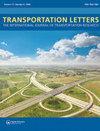引入三相交通信号灯替代路口的概念
IF 3.3
3区 工程技术
Q2 TRANSPORTATION
Transportation Letters-The International Journal of Transportation Research
Pub Date : 2025-01-02
DOI:10.1080/19427867.2024.2334101
引用次数: 0
摘要
在交通需求超过通行能力的交叉路口,减少信号灯相位数量可能有助于提高运行性能。替代交叉路口可能有助于实现减少相位的目标;但是,重新设计交叉路口可能需要更多的时间。本文章由计算机程序翻译,如有差异,请以英文原文为准。
Introducing the concept of alternative intersections with three-phase traffic signals
At intersections where traffic demand is above capacity, reducing the number of signal phases may help operational performance. Alternative intersections may help achieve the reduction; however, retrofits to alternatives with two-phase signals may be impactful and unpopular. Our study evaluates five alternative signalized intersections with three critical phases, namely partial median U-turn intersection (MUT), partial continuous-flow intersection (CFI), a combination of MUT and CFI (MUT/CFI combo), reverse reduced conflict intersection (reverse RCI), and thru-cut. Three-phase designs may provide better capacity than conventional intersections with fewer impacts than two-phase intersections and, therefore, may be more palatable to stakeholders. A wide range of simulation scenarios were tested to evaluate the performance of the intersections using VISSIM and the Surrogate Safety Assessment Model. Based on the results, all three-phase designs outperformed the conventional design in terms of traffic operation. The partial CFI and MUT/CFI combo yielded the fewest conflicts among the designs evaluated.
求助全文
通过发布文献求助,成功后即可免费获取论文全文。
去求助
来源期刊

Transportation Letters-The International Journal of Transportation Research
TRANSPORTATION SCIENCE & TECHNOLOGY-
CiteScore
6.40
自引率
14.30%
发文量
79
审稿时长
>12 weeks
期刊介绍:
Transportation Letters: The International Journal of Transportation Research is a quarterly journal that publishes high-quality peer-reviewed and mini-review papers as well as technical notes and book reviews on the state-of-the-art in transportation research.
The focus of Transportation Letters is on analytical and empirical findings, methodological papers, and theoretical and conceptual insights across all areas of research. Review resource papers that merge descriptions of the state-of-the-art with innovative and new methodological, theoretical, and conceptual insights spanning all areas of transportation research are invited and of particular interest.
 求助内容:
求助内容: 应助结果提醒方式:
应助结果提醒方式:


